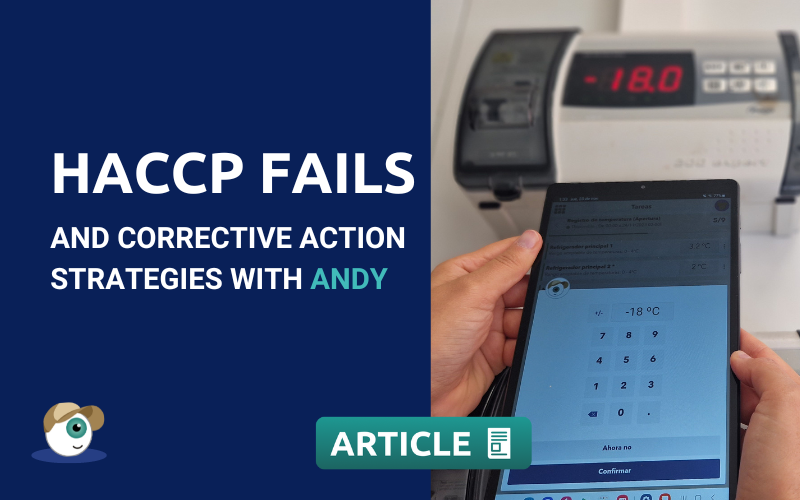HACCP Fails and effective corrective action strategies with Andy

In today’s globalised food service industry, every step in the food chain carries the potential for contamination or hazards that can lead to foodborne illness.
The Hazard Analysis and Critical Control Points (HACCP) system serves as a critical line of defense, identifying and managing these hazards at specific points in the food production process.
By identifying Critical Control Points (CCPs) – points where contamination can occur or be prevented – and implementing specific control measures, the system helps ensure food safety throughout the production line.
However, even the most well-designed HACCP system can encounter unexpected deviations.
These so called “HACCP fails” occur when critical control limits are breached or control measures are not followed effectively.
The consequences of neglecting HACCP deviations can be severe: contaminated food can lead to outbreaks of foodborne illness, causing significant harm to consumers and potentially devastating consequences for businesses. Recalls, fines, and even legal repercussions can follow a food safety incident.
This is where corrective actions become crucial.
By taking swift and effective action in response to deviations, food businesses can mitigate risks, prevent contaminated food from reaching consumers, and ensure the integrity of their HACCP system.
Let’s find out more about HACCP fails and their corrective actions in this post.
Identifying HACCP Fails
There are several ways in which HACCP systems can fail:
Temperature deviations
Temperature deviations can occur due to equipment malfunction, improper calibration of thermometers, or human error during storage or processing.
For instance, exceeding the recommended storage temperature for a ready-to-eat meat product could allow the growth of harmful bacteria.
Improper sanitation practices
Inadequate cleaning and sanitation protocols can lead to cross-contamination between food products or equipment. This could involve scenarios like using the same cutting board for raw and cooked meat, or failing to properly sanitise work surfaces after handling allergens.
Improper holding times
HACCP often dictates specific timeframes for holding potentially hazardous foods at certain temperatures. Deviations can occur if cooked foods are left out for too long in the “danger zone” (between 40°F and 140°F), allowing bacteria to multiply. Conversely, holding foods at excessively cold temperatures for extended periods could create ideal conditions for the growth of certain pathogens.
Supplier control issues
HACCP plans often rely on receiving safe ingredients from reliable suppliers. However, HACCP fails can occur if incoming ingredients are not properly inspected or documented, or if there’s a breakdown in communication regarding potential hazards within the supply chain.
Allergen cross-contact
Strict allergen control is crucial in HACCP plans, especially for facilities handling products with common allergens like peanuts, soy, or shellfish. HACCP deviations can happen if dedicated equipment is not used for allergen-containing products, or if there’s inadequate cleaning and sanitation between processing different allergen-containing and non-allergenic foods.
Packaging issues
Proper packaging plays a vital role in protecting food from contamination. Deviations can occur if packaging materials are damaged or compromised during processing, storage, or transportation, potentially exposing food to contaminants.
Documentation issues
Incomplete or inaccurate records can compromise the effectiveness of the HACCP system. This could involve failing to document CCP monitoring data, or neglecting to record corrective actions taken in response to deviations.
Lack of staff training
Insufficient training for staff on HACCP procedures and food safety risks can lead to knowledge gaps and improper practices. This could involve inadequate understanding of proper handwashing techniques, or not following established procedures for receiving and inspecting incoming ingredients.
Deviation management failures
Even if a deviation is identified, the response itself can be a point of failure. This could involve failing to take corrective actions within an appropriate timeframe, not conducting a thorough root cause analysis to prevent future occurrences, or neglecting to document the entire deviation management process.
The importance of corrective actions to counteract HACCP Fails
When deviations from critical control limits occur – in other words, when HACCP Fails occur 🙂 -, acting swiftly is essential to minimise the risk of contaminated food reaching consumers.
Here’s why:
Mitigating foodborne illnesses: Foodborne illnesses can have devastating consequences for consumers, causing anything from mild discomfort to severe illness or even death. Taking corrective actions promptly helps prevent contaminated food from entering the food chain, safeguarding public health.
Preventing contamination spread: Deviations can create opportunities for contamination to spread throughout the food processing environment. By addressing deviations quickly, businesses can minimise the potential for cross-contamination between food products, equipment, and surfaces.
Maintaining HACCP system integrity: Failure to address deviations can erode the trust and effectiveness of the entire HACCP system. Prompt corrective actions demonstrate a commitment to continuous improvement and ensure all aspects of the production process are functioning as intended.
Now, let’s consider the potential consequences of neglecting corrective actions:
Legal repercussions: Regulatory bodies take food safety violations seriously. Ignoring deviations could lead to investigations, fines, or even product recalls. In severe cases, negligence might result in criminal charges.
Financial losses: Recalls, product disposal, and potential lawsuits following a foodborne illness outbreak can inflict significant financial damage on a business. The cost of lost sales, brand reputation damage, and potential production shutdowns can be immense.
Consumer confidence erosion: News of a food safety incident can quickly tarnish a business’s reputation and erode consumer trust. Consumers expect brands to prioritise food safety, and neglecting corrective actions can lead to a significant loss of consumer confidence.
Effective corrective action examples
A well-defined HACCP plan outlines not only the critical control points but also the specific corrective actions to be taken when deviations occur.
Here are some examples of effective corrective actions for different HACCP deviations we have seen in our customers’ kitchens:
HACCP FAIL 1: Temperature Deviation
Deviation ▶ During a routine temperature check, a thermometre in the walk-in refrigerator malfunctions, and the internal temperature is discovered to be 10°C – exceeding the safe storage temperature for cooked chicken breasts (below 4°C).
Corrective Action ▶ Immediately remove all cooked chicken breasts from the refrigerator and assess their safety. If the temperature hasn’t been in the danger zone for an extended period (typically 4 hours), the chicken may be deemed safe for immediate consumption or further processing at a safe temperature.
If the unsafe temperature exposure time is excessive, the chicken must be discarded to prevent potential bacterial growth and foodborne illness risks.
Investigate the cause of the thermometre malfunction. This could involve calibrating the thermometre, replacing it if faulty, or implementing a secondary temperature monitoring system for additional verification.
Document the entire deviation and corrective action process, including the time of the deviation, the corrective actions taken, and the investigation findings.
Outcome ▶ Prompt action prevents potentially contaminated chicken from reaching consumers. Investigating the root cause helps prevent similar failures in the future. Proper documentation maintains a transparent record of the incident and response.
HACCP FAIL 2: Improper sanitation practices
Deviation ▶ During a routine inspection, it’s discovered that a food handler is not properly sanitising their hands after handling raw meat before preparing a salad.
Corrective Action ▶ Immediately halt food preparation until the food handler properly sanitises their hands according to established protocols.
Re-educate the food handler on proper handwashing techniques and the importance of preventing cross-contamination.
Consider implementing additional handwashing stations or visual reminders throughout the processing area.
Document the deviation and the corrective actions taken, including the retraining provided to the food handler.
Outcome ▶ Swift intervention prevents potential cross-contamination between raw and cooked food products. Re-education and visual aids minimise the risk of similar incidents in the future. Documentation demonstrates commitment to food safety training and compliance.
Scenario 3: Supplier control issue
Deviation ▶ A routine inspection of incoming deliveries reveals that a batch of lettuce from a supplier has exceeded acceptable microbiological limits, indicating potential contamination.
Corrective Action ▶ Immediately reject the contaminated lettuce shipment and return it to the supplier.
Investigate the source of the contamination and communicate the issue to the supplier for corrective action on their end.
Identify alternative suppliers with a proven track record of food safety practices to ensure a reliable source of safe ingredients.
Document the deviation, including the details of the contaminated shipment, communication with the supplier, and the search for alternative sources.
Outcome ▶ Rejecting contaminated ingredients prevents them from entering the food chain. Investigating the source helps prevent future issues. Identifying reliable suppliers enhances the overall safety of the food production process. Documentation maintains a transparent record of the incident and response.
These examples showcase how effective corrective actions can mitigate risks after HACCP fails and ensure food safety.
By identifying the deviation, taking immediate steps to address it, investigating the root cause, and documenting the process, your food businesses can safeguard consumers and maintain a robust HACCP system.
But there’s an easier way!
Enter Andy, leading food safety digital assistant.
Andy App – leading food safety digital assistant – can help prevent HACCP fails
As we’ve seen in this post, maintaining a robust HACCP system and preventing deviations requires constant vigilance and meticulous record-keeping.
This is where Andy, your leading food safety digital assistant, steps in, becoming your trusted partner in ensuring food safety in all your kitchens.
Here’s how Andy empowers your teams to prevent HACCP fails:
-
Enhanced monitoring and verification
- Andy automates routine monitoring tasks, reminding staff to check CCPs like temperatures, sanitation procedures, and equipment functionality.
- Real-time data collection and analysis allows for immediate identification of potential deviations, enabling faster intervention.
- A customisable dashboard provide a clear visual overview of critical control points, highlighting areas that may require attention.
-
Streamlined corrective action management
- Andy guides you through a predefined corrective action workflow, ensuring a consistent and effective response to deviations.
- Automated documentation of deviations and corrective actions simplifies record-keeping and facilitates traceability.
- Root cause analysis tools within Andy help identify the underlying causes of deviations, allowing for targeted preventative measures.
-
Improved staff training and communication
- Andy provides readily available training modules on HACCP principles, specific procedures, and proper food safety practices.
- Automated alerts and reminders keep staff informed about critical tasks and potential risks.
- Two-way communication features allow for real-time troubleshooting and clarification of procedures, minimising human error.
-
Proactive risk assessment and management
- Andy analyses historical data and trends to identify recurring HACCP fails or areas with increased risk of failure.
- Predictive analytics capabilities help anticipate potential problems before they occur, allowing for preventative measures.
- Integration with supplier management systems facilitates monitoring of incoming ingredients and potential risks within the supply chain.
-
Enhanced Regulatory Compliance
- Andy ensures all HACCP procedures and documentation are readily accessible and up-to-date across all stores.
- Automated audit and compliance checks simplify preparation for regulatory inspections.
- Real-time data and reporting features allow for transparent communication with regulatory authorities.
By using Andy’s comprehensive set of HACCP and labelling tools, you can significantly reduce the risk of HACCP failures in your food safety program.
Trust Andy -like the leading foodservice brands do – and prevent HACCP fails while protecting your consumers and your business.

